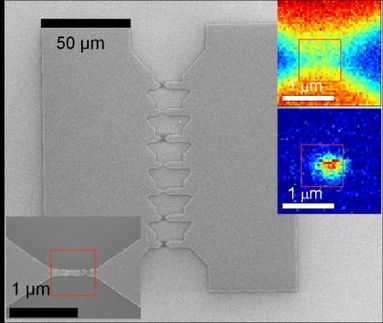Researchers measure elusive repulsive force from quantum fluctuations
Exotic force could lead to a wide range of nanomechanical devices based on quantum levitation
Advertisement
Researchers from Harvard University and the National Institutes of Health (NIH) have measured, for the first time, a repulsive quantum mechanical force that could be harnessed and tailored for a wide range of new nanotechnology applications. The study, led by Federico Capasso, Robert L. Wallace Professor of Applied Physics at Harvard's School of Engineering and Applied Science (SEAS), will be published in Nature .
The discovery builds on previous work related to what is called the Casimir force. While long considered only of theoretical interest, physicists discovered that this attractive force, caused by quantum fluctuations of the energy associated with Heisenberg's uncertainty principle, becomes significant when the space between two metallic surfaces, such as two mirrors facing one another, measures less than about 100 nanometers.
"When two surfaces of the same material, such as gold, are separated by vacuum, air, or a fluid, the resulting force is always attractive," explained Capasso.
Remarkably, but in keeping with quantum theory, when the scientists replaced one of the two metallic surfaces immersed in a fluid with one made of silica, the force between them switched from attractive to repulsive. As a result, for the first time, Capasso and his colleagues measured what they have deemed a repulsive Casimir. To measure the repulsive force, the team immersed a gold coated microsphere attached to a mechanical cantilever in a liquid (bromobenzene) and measured its deflection as the distance from a nearby silica plate was varied.
"Repulsive Casimir forces are of great interest since they can be used in new ultra-sensitive force and torque sensors to levitate an object immersed in a fluid at nanometric distances above a surface. Further, these objects are free to rotate or translate relative to each other with minimal static friction because their surfaces never come into direct contact," said Capasso.
By contrast, attractive Casimir forces can limit the ultimate miniaturization of small-scale devices known as Micro Electromechanical Systems (MEMS), a technology widely used to trigger the release of airbags in cars, as the attractive forces may push together moving parts and render them inoperable, an effect known as stiction.
Potential applications of the team's finding include the development of nanoscale-bearings based on quantum levitation suitable for situations when ultra-low static friction among micro- or nano-fabricated mechanical parts is necessary. Specifically, the researchers envision new types of nanoscale compasses, accelerometers, and gyroscopes.
Other news from the department science
These products might interest you
Most read news
More news from our other portals
See the theme worlds for related content
Topic world Sensor technology
Sensor technology has revolutionized the chemical industry by providing accurate, timely and reliable data across a wide range of processes. From monitoring critical parameters in production lines to early detection of potential malfunctions or hazards, sensors are the silent sentinels that ensure quality, efficiency and safety.

Topic world Sensor technology
Sensor technology has revolutionized the chemical industry by providing accurate, timely and reliable data across a wide range of processes. From monitoring critical parameters in production lines to early detection of potential malfunctions or hazards, sensors are the silent sentinels that ensure quality, efficiency and safety.
































































